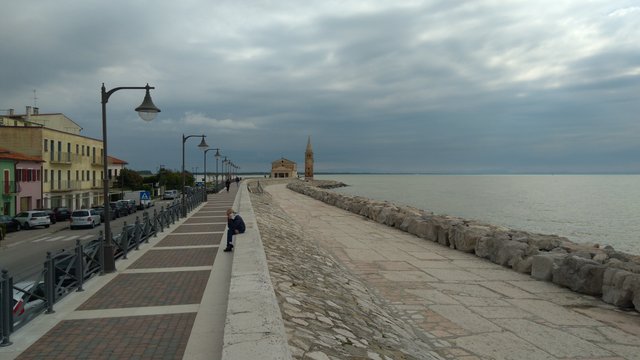What I learned about "Not saying" and a haiku for Mizu No Oto - Every Image Has Its Haiku

Photo by @marcoriccardi. Source

Dear friends, in the previous call for Mizu No Oto - Every Image Has Its Haiku there is an interesting and profound reflection about what has not been said in haiku and the importance that this, let's call it a mechanism, has in the aesthetic conformation of this poetic form. The text is entitled The eloquence of "not saying".
With beautiful simplicity (and with a lot of elegance, by the way) this reflection shortens:
A fundamental characteristic of haiku is to express a message with the least possible number of words. This quality is called, in a very Zen way, yohaku (余 白, empty dimension). This concept is also found in a type of Japanese painting called sumi-e, in which the painter draws only a few strokes of ink on a white sheet. The charm of these paintings is precisely because they are just hinted and mysterious: the figures are completed by the mind of the spectator.The empty dimension, the enunciation of meanings not expressed through suggestion, are a difficult and substantive part of haiku art. For the mind formed in the occidental aesthetic exercise, however, it is not an extraneous concept, although it is exercised from a communicative position, I believe, something different. When I read about the empty dimension, a concept of contemporary Literary Theory that points in that sense immediately came to my mind: the concept of interpretative cooperation. For Umberto Eco (1979/1993, p. 76), in Lector in fabula:
...a text is distinguished from other types of expressions by its greater complexity. The main reason for this complexity is precisely the fact that it is riddled with unspoken elements (cf. Ducrot, 1972). "Not said" means not manifest on the surface, at the level of the expression: but it is precisely those unspoken elements that must be updated at the stage of updating the content. For this, a text (with greater force than any other type of message) requires certain cooperative, active and conscious movements on the part of the reader.There is a coincidence in the way of understanding the interpretation of texts that, incidentally, the text must anticipate. I will allow myself to quote from the same book of Eco:
...a text is a product whose interpretative fate must form part of its own generative mechanism: to generate a text means to apply a strategy that includes the forecasts of the movements of the other; as happens, moreover, in any strategy. (p.79)Umberto Eco, like the poet Ogiwara Seisensui, quoted in The Eloquence of "not saying" ("The haiku is a circle: half of the circumference is drawn by the poet, the other half is completed by the reader") point to the same mechanism. The "unsaid", reviewed by Eco as a functional mechanism, which, it is worth highlighting, can have, and has, aesthetic values by providing interpretative openness to texts is, for haiku, the heart. Since a haiku, like the painting called sumi-e, shows what it means through suppression, suppression itself is the movement of meaning, of the soul of what is said. So "what is not said" is "what is said". Haiku elevates to a constitutive fundament what in the text is strategic complexity. And it is on this empty dimension that it builds its beauty. Finding the way to "not saying" seems to go through a lot of practice in "saying", and as we are trying to learn, here I go. I hope you enjoy my haiku for the thirty-first edition of Mizu No Oto - Every Image Has Its Haiku, promoved by @bananafish, this time with the really magnificent @marcoriccardi photography. As this edition is in English, I present first my haiku in this language (by the way, in English my third verse has an added meaning that it doesn't have in Spanish), and then a version in Spanish, which is my mother tongue, with free metrics. I am grateful.

A far lighthouse
Above the horizon.
Long waiting line.

Gracias por la compañía. Bienvenidos siempre.


¡Libertad para mi país!

Posted from my blog with SteemPress : http://adncabrera.vornix.blog/2019/05/23/what-i-learned-about-not-saying-and-a-haiku-for-mitzu-no-oto/
Being Italian, I am honored and pleased by the fact that you mentioned the great and late Umberto Eco.
Besides being one of my favorite novelists, I have studied some of his semiotic studies, in particular with regard to the "symbolic nebula" in which we are immersed.
It's a pleasant coincidence and your pride is very justified. Umberto Eco is one of the greatest authors of our time. He also marked my life. El nombre de la rosa is one of my favorite novels. But it wasn't with a novel that we started our love story, it was with Lector in fabula. You see, since I was very, very young, I knew I wanted to be a theorist, but in my country there are no formal studies to graduate in this area, so if you want to be a theorist hear, you must educate yourself and have the luck (I had it) of having teachers willing to help you. So you become a student of a few real teachers and a lot of paper teachers. He was one of my most beloved paper teachers. I read Eco, with the same fascination with which I have read the best novels, when I was a little over twenty years old, and I fell deeply in love. When he died, I gave a conference in his honor at my university and had a sad emptiness for a while.
Every time I read Eco, I know he was smiling (and laughing) at the world.